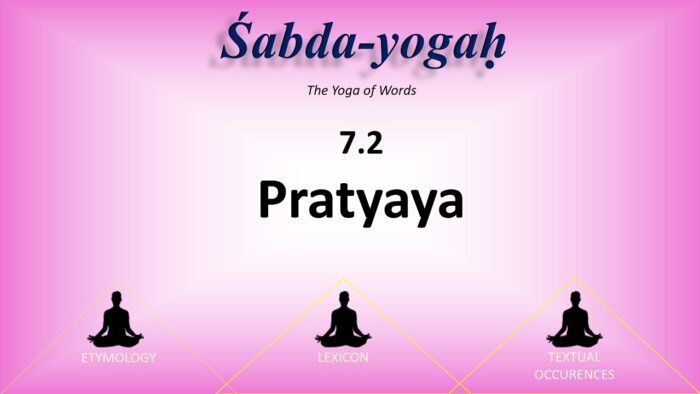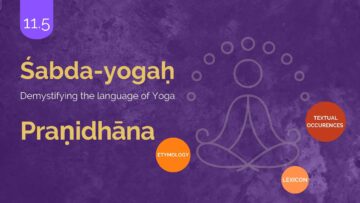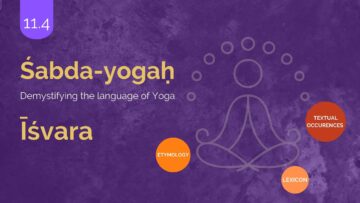Introduction
In this series, Yogic terminologies will be taken up and their –
- Etymological analysis,
- Lexical descriptions and
- Textual occurrences in Yogic literature and their commentaries, as available, will be presented. And finally observations will be made on the references.
Three texts – Yogasūtra, Haṭha-yoga-pradīpikā and Bhagavad-gītā are consulted for textual occurrences portion.
Śabda-yoga is intended to help students, teachers, and professionals of Yoga to develop a sound grammatical, contextual, and thereby an authentic and immersive understanding of Yoga terminologies.
7.2. Pratyaya
Etymology
प्रति+ इण् + अच् = प्रत्ययः
prati+ iṇ + ac = pratyayaḥ
प्रतिPratiis the prefix
इण्- iṇis the root word which means movement (गतौ)
अच्acis the suffix . This suffix is added based on the grammatical rule एरच्erac (aṣṭādhyāyī 3.3.56) in the meaning of the act, and also the cause
प्रत्येतिअनेनइतिप्रत्ययः – that by which the goal is achieved (instrumental sense) – cause
प्रतीयतेइतिप्रत्ययः- the act of going – the act
Lexicon
There is one reference in the Amarakośa 3.3.148
प्रत्ययोऽधीनशपथज्ञानविश्वासहेतुषु
pratyayo’dhīnaśapathajñānaviśvāsahetuṣu
Pratyaya is used to mean the one who is subservient, vow, knowledge, faith& cause
It will be interesting to note that from the references to be discussed below, in Yogasūtras the meanings cause and knowledge are used for the word Pratyaya.
Textual Occurrences
Yogasūtra
There are nine references to the term in Yogasūtras. It is interesting to note that this term appears in all the four chapters of the work. A chapterwise summary is given below –
Chapter 1
There are two references in the first chapter. They are as follows –
अभावप्रययालम्बनावृत्तिर्निद्रा॥१.१०॥
विरामप्रत्ययाभ्यासपूर्वःसंस्कारशेषोऽन्यः॥१.१८॥
abhāvaprayayālambanāvṛttirnidrā .. 1.10 ..
virāmapratyayābhyāsapūrvaḥsaṃskāraśeṣo’nyaḥ .. 1.18..
Summary: The occurrences in the first chapter describe the vṛttinidrā and also AsaṃprajñātaSamādhi respectively. Base on Tattva-vaiśāradīcommentary it can be stated that in the both occasions the word Pratyaya has been used to mean the cause. (जाग्रत्स्वप्नवृत्तीनामभावस्तस्य प्रत्ययः कारणम्, विरामो वृत्तीनामभावस्तस्य प्रत्ययः कारणम् – jāgratsvapnavṛttīnāmabhāvastasyapratyayaḥkāraṇam(1.10) , virāmovṛttīnāmabhāvastasyapratyayaḥkāraṇam (1.18)- Tattva-vaiśāradī)Nidrā is defined as that activity of the mind which takes support of the cause/pratyaya of the absence (Tamas) of the waking and dreaming state. AsaṃprajñātaSamādhi is defined as the state which arises due to the practice of the pratyaya/cause of absence (para-vairāgya) of the cittavṛttis (Virāma), where only the subliminal impressions only will remain the citta.
Chapter 2
द्रष्टादृशिमात्रःशुद्धोऽपिप्रत्ययानुपश्यः॥२.२०॥ –
draṣṭādṛśimātraḥśuddho’pipratyayānupaśyaḥ .. 2.20 .. –
Summary: The lone occurrence of the term Pratyaya in this chapter is in the context of defining the draṣṭā- the consciousness. Here the word pratyaya is used to mean knowledge/vṛtti (प्रत्ययं बुद्धिवृत्तिमनुसृत्य पश्यतीति pratyayaṃbuddhivṛttimanusṛtyapaśyatīti – yogamaṇiprabhā commentary). Consciousness is defined as that which is pure/unchanging yet is (as if) watching the Pratyaya/activities of the mind/knowledge that arises in the citta.
Chapter 3
There are five occurrences of the term in this chapter. They are as follows –
तत्रप्रत्ययैकतानताध्यानम्॥३.२॥
ततःपुनःशान्तोदितौतुल्यप्रत्ययौचित्तस्यैकाग्रतापरिणामः॥३.१२॥
शब्दार्थप्रत्ययानामितरेतराध्यासात्संकरस्तत्प्रविभागसंयमात्सर्वभूतरुतज्ञानम्॥३.१७॥
प्रत्ययस्यपरचित्तज्ञानम्॥३.१९॥
सत्त्वपुरुषयोरत्यन्तासंकीर्णयोःप्रत्ययाविशेषोभोगःपरार्थात्स्वार्थसंयमात्पुरुषज्ञानम्॥३.३५॥
tatrapratyayaikatānatādhyānam .. 3.2 ..
tataḥpunaḥśāntoditautulyapratyayaucittasyaikāgratāpariṇāmaḥ .. 3.12 ..
śabdārthapratyayānāmitaretarādhyāsātsaṃkarastatpravibhāgasaṃyamātsarvabhūtarutajñānam .. 3.17 ..
pratyayasyaparacittajñānam .. 3.19 ..
sattvapuruṣayoratyantāsaṃkīrṇayoḥpratyayāviśeṣobhogaḥparārthātsvārthasaṃyamātpuruṣajñānam .. 3.35 ..
Summary: In all these five occurrences,based on the traditional commentaries, it can be stated that Pratyaya is used to mean knowledge/vṛtti in the citta. Dhyānais defined (3.2) as a state where there is a flow of homogenous pratyayas/vṛttis in the citta. Subsequently, ekagratāpariṇāma (change towards single-pointedness) of the citta is described (3.12) as the state where the subsided and arisen pratyayas (vṛtti) of the citta are identical. The ability to understand all the sounds made by various beings is discussed next (3.17). It is said to arise by segregating the word/object/pratyaya (vṛtti/knowledge) that get mutually superimposed in the process of perceiving any object. In the next reference in this chapter, the special power of knowing the other persons Citta is said (3.19) to be attained when Saṃyama (dhāraṇā-dhyāna-samādhi)is done on Pratyaya (cittavṛtti). The final reference in chapter is about attaining the knowledge about consciousness/puruṣa (3.35). Normally pratyaya/knowledge/virtti about the Sattva (citta) and the Puruṣa are super imposed and grasped as not different from each other. When by discrimination (viveka) one focusses only on the Puruṣa, then the knowledge of the consciousness (puruṣa-jñāna) is attained.
Chapter 4
There is a solitary reference to Pratyaya in this chapter. It is as follows –
तच्छिद्रेषुप्रत्ययान्तराणिसंस्कारेभ्यः॥४.२७॥
tacchidreṣupratyayāntarāṇisaṃskārebhyaḥ .. 4.27 ..
Summary: Here the word Pratyaya is used in the sense of Vṛtti/knowledge. Even in the mind that has attained viveka, in the gaps that may exist in the viveka, the Pratyayas/notions/vṛttis that I am, this is mine etc will arise, from the already weakening earlier subliminal impressions (that are outwardly).
Bhagavadgītā – There are no entries in this text on Pratyaya.
Haṭhayogapradīpikā
There is just one reference to the usage of the term Pratyaya in this text. It is as follows –
उन्मन्यवाप्यतेशीघ्रंभ्रूध्यानंममसम्मतम्।
राजयोगपदंप्राप्तुंसुखोपायोऽल्पचेतसाम्।
सद्यःप्रत्ययसन्धायीजायतेनादजोलयः॥४.८०॥
unmanyavāpyateśīghraṃ
bhrūdhyānaṃ mama sammatam .
rājayogapadaṃprāptuṃsukhopāyo’lpacetasām .
sadyaḥpratyayasandhāyī
jāyatenādajolayaḥ .. 4.80 ..
Summary: The context is the description of the practice Nādānusandhāna for attainment of state of Laya (absorption of the mind in the object of the focus). In the process of Nādānusandhāna meditating the space between the eyebrows is prescribed, where by Unmanī– the state of Samādhi is achieved. The text states that this practice of meditating inbetween the eyebrows – as sadyaḥpratyaya-sandhāyīwhich is described in the Jyotsnā commentary (सद्यःशीघ्रंप्रत्ययंप्रतीतिंसन्दधातीतिप्रत्ययसन्धायीप्रतीतिकरोजायतेप्रादुर्भवति -sadyaḥśīghraṃpratyayaṃpratītiṃsandadhātītipratyayasandhāyīpratītikarojāyateprādurbhavati)as that which leads to quick manifestation of the state of Samādhi. Quick manifestation or the realization of the state of Samādhi is the intended meaning of the expression Pratyaya-sandhāyī, where Pratyaya refers to the realization/understanding.
Tabulation of Textual References
Observation
Thus as could be seen from the references above –
1)Among the three Yogasūtra texts – Pratyaya is profusely used in the Yogasutras. Two meanings – Cause and knowledge/vṛtti are given to the term in this text.
2)Bhagavadgītā does not use this word
3)In Haṭhayogapradīpikā is used in the sense of understanding/realization.
Hence these contextual significances and shades of meanings of the term Pratyaya have to be noted in the process of discussing the term Pratyaya in Yogic context.
References
- Advaitaśāradā – https://advaitasharada.sringeri.net/
- Amarakoṣasampat – http://amara.aupasana.com/
- Aṣṭādhyāyī – https://ashtadhyayi.com/
- Aksharamukha – https://aksharamukha.appspot.com/
- Avyayakośaḥ, śrīśrīvatsāṅkācāryaḥ, saṃskṛtavidyāsamitiḥ, chennai, 2004
- Gītā Supersite – https://www.Gītāsupersite.iitk.ac.in/
- Nāmaliṅgānuśāsana alias amarakoṣa of amarasiṃha with the commentary vyākhyāsudhā or rāmāśramī by bhānujidīkṣita, Edited with notes by M.M.PanditShivadattaDadimatha, ChaukhambaSaṃskṛtaPrathisthan, Delhi, Reprint 2002
- śabdārthakaustubha, cakravartīśrīnivāsagopālācārya, Vol 4, Bappco Publication, Bengaluru, Reprint 2009
- Yoga-vaiśāradī – https://kymyogavaisharadi.org/
Unit 7 To be Continued…
Links for previous posts in this unit
Disclaimer: The opinions expressed in this article belong to the author. Indic Today is neither responsible nor liable for the accuracy, completeness, suitability, or validity of any information in the article.













